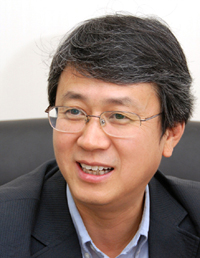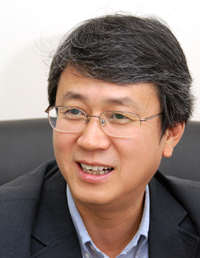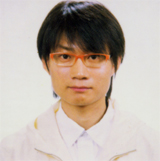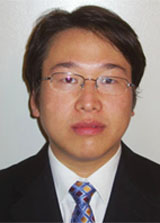department+of+materials+science+and+engineering
-
 Method to Synthesize New Lithium Ion Battery Cathode Material Identified
A KAIST research team headed by Prof. Do-Kyung Kim at the Department of Materials Science and Engineering developed a technology to synthesize a new lithium ion battery spinel cathode which is regarded as a core part of hybrid and lithium battery cars.
The research was conducted in collaboration with a research team of Prof. Yi Cui at Stanford University"s Department of Chemistry. Their findings were introduced in the November issue of Nano Letters, one of the leading academic journals in nano-science.
The newly synthesized lithium ion battery spinel cathode known as spinel LiMn2O4 nanorods is attracting interests as an alternative cathode material since it is a low-cost, environmentally friendly substance for Li-ion battery cathodes. Its raw material is also highly available.
Lithium ion batteries with high energy and power density are important for consumer electronic devices, portable power tools, and vehicle electrification. LixCoO2 is a commonly used cathode material in commercial lithium iron batteries. However, the high cost, toxicity, and limited abundance of cobalt have been recognized to be disadvantageous.
2008.11.20 View 11835
Method to Synthesize New Lithium Ion Battery Cathode Material Identified
A KAIST research team headed by Prof. Do-Kyung Kim at the Department of Materials Science and Engineering developed a technology to synthesize a new lithium ion battery spinel cathode which is regarded as a core part of hybrid and lithium battery cars.
The research was conducted in collaboration with a research team of Prof. Yi Cui at Stanford University"s Department of Chemistry. Their findings were introduced in the November issue of Nano Letters, one of the leading academic journals in nano-science.
The newly synthesized lithium ion battery spinel cathode known as spinel LiMn2O4 nanorods is attracting interests as an alternative cathode material since it is a low-cost, environmentally friendly substance for Li-ion battery cathodes. Its raw material is also highly available.
Lithium ion batteries with high energy and power density are important for consumer electronic devices, portable power tools, and vehicle electrification. LixCoO2 is a commonly used cathode material in commercial lithium iron batteries. However, the high cost, toxicity, and limited abundance of cobalt have been recognized to be disadvantageous.
2008.11.20 View 11835 -
 KAIST Team Identifies Nano-scale Origin of Toughness in Rare Earth-added Silicon Carbide
A research team led by Prof. Do-Kyung Kim of the Department of Materials Science and Engineering of KAIST has identified the nano-scale origin of the toughness in rare-earth doped silicon carbide (RE-SiC), university sources said on Monday (Oct. 6).
The research was conducted jointly with a U.S. team headed by Prof. R. O. Ritchie of the Department of Materials Science and Engineering, University of California, Berkeley.
The findings were carried in the online edition of Nano Letters published by the American Chemical Association.
Silicon carbide, a ceramic material known to be one of the hardest substances, are potential candidate materials for many ultrahigh-temperature structural applications. For example, if SiC, instead of metallic alloys, is used in gas-turbine engines for power generation and aerospace applications, operating temperatures of many hundred degrees higher can be obtained with a consequent dramatic increase in thermodynamic efficiency and reduced fuel consumption. However, the use of such ceramic materials has so far been severely limited since the origin of the toughness in RE-SiC remained unknown thus far.
In order to investigate the origin of the toughness in RE-SiC, the researchers attempted to examine the mechanistic nature of the cracking events, which they found to occur precisely along the interface between SiC grains and the nano-scale grain-boundary phase, by using ultrahigh-resolution transmission electron microscopy and atomic-scale spectroscopy. The research found that for optimal toughness, the relative elastic modulus across the grain-boundary phase and the interfacial fracture toughness are the most critical material parameters; both can be altered with appropriate choice of rare-earth elements.
In addition to identifying the nano-scale origin of the toughness in RE-SiC, the findings also contributed to precisely predicting how the use of various rare-earth elements lead to difference in toughness.
University sources said that the findings will significantly advance the date when RE-SiC will replace metallic alloys in gas-turbine engines for power generation and aerospace applications.
2008.10.08 View 13933
KAIST Team Identifies Nano-scale Origin of Toughness in Rare Earth-added Silicon Carbide
A research team led by Prof. Do-Kyung Kim of the Department of Materials Science and Engineering of KAIST has identified the nano-scale origin of the toughness in rare-earth doped silicon carbide (RE-SiC), university sources said on Monday (Oct. 6).
The research was conducted jointly with a U.S. team headed by Prof. R. O. Ritchie of the Department of Materials Science and Engineering, University of California, Berkeley.
The findings were carried in the online edition of Nano Letters published by the American Chemical Association.
Silicon carbide, a ceramic material known to be one of the hardest substances, are potential candidate materials for many ultrahigh-temperature structural applications. For example, if SiC, instead of metallic alloys, is used in gas-turbine engines for power generation and aerospace applications, operating temperatures of many hundred degrees higher can be obtained with a consequent dramatic increase in thermodynamic efficiency and reduced fuel consumption. However, the use of such ceramic materials has so far been severely limited since the origin of the toughness in RE-SiC remained unknown thus far.
In order to investigate the origin of the toughness in RE-SiC, the researchers attempted to examine the mechanistic nature of the cracking events, which they found to occur precisely along the interface between SiC grains and the nano-scale grain-boundary phase, by using ultrahigh-resolution transmission electron microscopy and atomic-scale spectroscopy. The research found that for optimal toughness, the relative elastic modulus across the grain-boundary phase and the interfacial fracture toughness are the most critical material parameters; both can be altered with appropriate choice of rare-earth elements.
In addition to identifying the nano-scale origin of the toughness in RE-SiC, the findings also contributed to precisely predicting how the use of various rare-earth elements lead to difference in toughness.
University sources said that the findings will significantly advance the date when RE-SiC will replace metallic alloys in gas-turbine engines for power generation and aerospace applications.
2008.10.08 View 13933 -
 KAIST, Nokia Launch Joint Research Project
Prof. Kyung Wook Baik of KAIST and his research team in the Department of Materials Science and Engineering announced the launch of a joint research project with Nokia, the world"s leading mobile phone supplier, on Jan. 24.
It is the first time that Nokia runs a joint research project with a Korean university or research institute.
Under the agreement, KAIST will develop a new ultrasonic welding process to bond various modules for mobile phones. The ultrasonic welding process, an indigenous technology patented by the research team led by Prof. Baik, is expected to contribute greatly to improving productivity in manufacturing mobile phones, as well as making it smaller and lighter.
The research period is six month and the project fund amounts to 35,000 euros.
2008.01.29 View 11416
KAIST, Nokia Launch Joint Research Project
Prof. Kyung Wook Baik of KAIST and his research team in the Department of Materials Science and Engineering announced the launch of a joint research project with Nokia, the world"s leading mobile phone supplier, on Jan. 24.
It is the first time that Nokia runs a joint research project with a Korean university or research institute.
Under the agreement, KAIST will develop a new ultrasonic welding process to bond various modules for mobile phones. The ultrasonic welding process, an indigenous technology patented by the research team led by Prof. Baik, is expected to contribute greatly to improving productivity in manufacturing mobile phones, as well as making it smaller and lighter.
The research period is six month and the project fund amounts to 35,000 euros.
2008.01.29 View 11416 -
 Ki-Won Lee Receives Best Student Paper Award
Ki-Won Lee Receives Best Student Paper Award
Ki-Won Lee, a doctoral student of Materials Science & Engineering, has received the Best Student Paper Award ‘Motorola Fellowship Award’ at 2007 Electronic Components and Technology Conference (ECTC).
Lee’s paper is about a new bonding process of anisotropic conductive film using ultrasonic wave, which applies ultrasonic wave, instead of thermal compression, at the room temperature to reduce the process time from ten to three seconds.
The recipients of Motorola Fellowship Award are selected by IEEE Components, Packaging and Manufacturing Technology Society, and Motorola awards special scholarship to recipients. The ECTC is the world’s largest yearly conference concerning electronic packaging technologies with more than 1,000 attendees and more than 300 presented papers.
2007.07.02 View 16452
Ki-Won Lee Receives Best Student Paper Award
Ki-Won Lee Receives Best Student Paper Award
Ki-Won Lee, a doctoral student of Materials Science & Engineering, has received the Best Student Paper Award ‘Motorola Fellowship Award’ at 2007 Electronic Components and Technology Conference (ECTC).
Lee’s paper is about a new bonding process of anisotropic conductive film using ultrasonic wave, which applies ultrasonic wave, instead of thermal compression, at the room temperature to reduce the process time from ten to three seconds.
The recipients of Motorola Fellowship Award are selected by IEEE Components, Packaging and Manufacturing Technology Society, and Motorola awards special scholarship to recipients. The ECTC is the world’s largest yearly conference concerning electronic packaging technologies with more than 1,000 attendees and more than 300 presented papers.
2007.07.02 View 16452 -
 KAIST Graduate Selected As Winner of IEEE Outstanding Young Engineer Award
- First Korean winner of IEEE Outstanding Young Engineer Award
Dr. Myung-Jin Rhim, Bachelor, Master, and Ph.D of KAIST, has been selected to receive 2007 Outstanding Young Engineer Award by the Institute of Electrical and Electronics Engineers (IEEE) Components, Packaging, and Manufacturing Technology (CPMT) Society. Dr. Rhim will be the first Korean winner of the award.
Dr. Rhim received his Ph.D of Materials Science & Engineering at KAIST in 2001 and has made outstanding research outputs, such as 28 papers at international journals covered by Science Citation Index (SCI) and 12 international patents. He has been also listed in Marquis Who’s Who in the World, Who’s Who of Emerging Leaders, Who’s Who in Asia, and Outstanding Intellectual of the 21st Century, 21st Century Award for Achievement published by the International Biographical Centre of Cambridge, England.
IEEE CPMT Society has yearly awarded the Outstanding Young Engineer Award to a scientist or engineer of electronic components, packaging, and manufacturing technology prior to his or her 35th birthday in recognition of his or her research achievements. Dr. Rhim is now in his postdoctoral program at Georgia Institute of Technology in USA.
2007.06.14 View 15290
KAIST Graduate Selected As Winner of IEEE Outstanding Young Engineer Award
- First Korean winner of IEEE Outstanding Young Engineer Award
Dr. Myung-Jin Rhim, Bachelor, Master, and Ph.D of KAIST, has been selected to receive 2007 Outstanding Young Engineer Award by the Institute of Electrical and Electronics Engineers (IEEE) Components, Packaging, and Manufacturing Technology (CPMT) Society. Dr. Rhim will be the first Korean winner of the award.
Dr. Rhim received his Ph.D of Materials Science & Engineering at KAIST in 2001 and has made outstanding research outputs, such as 28 papers at international journals covered by Science Citation Index (SCI) and 12 international patents. He has been also listed in Marquis Who’s Who in the World, Who’s Who of Emerging Leaders, Who’s Who in Asia, and Outstanding Intellectual of the 21st Century, 21st Century Award for Achievement published by the International Biographical Centre of Cambridge, England.
IEEE CPMT Society has yearly awarded the Outstanding Young Engineer Award to a scientist or engineer of electronic components, packaging, and manufacturing technology prior to his or her 35th birthday in recognition of his or her research achievements. Dr. Rhim is now in his postdoctoral program at Georgia Institute of Technology in USA.
2007.06.14 View 15290 -
 Professor Chan Beum Park, requested for joint international research by a German biotechnology enterprise.
- Bitop AG (Germany) requested a joint development of medicines for Alzheimer’s disease
- The meaning of the financial support by European enterprise to the research result of domestic university.
Professor Chan Beum Park (Department of Materials Science and Engineering in KAIST/ President Nam Pyo Suh) has been entrusted with a joint international research for the development of medicines for Alzheimer’s disease from Bitop AG, German biotechnology enterprise.
KAIST recently agreed with Bitop AG to cooperate for a research program pursuing the development of inhibitors that inhibit the formation of plaque relevant to amyloid diseases like Alzheimer’s disease. Based on this agreement, KAIST will be provided with a financial support of sixty thousands Euro (about 74 million won) from Bitop AG.
Professor Park will perform the screening of inhibitors, which are the core of the research, and KAIST will share patent rights from the research with Bitop AG.
It is known that various degenerative nerve diseases like Alzheimer’s disease, Parkinson’s disease, mad cow disease, and so on arise mainly from the accumulation of pathological protein plaque termed amyloid, and environmental stress accelerates the diseases.
So far, no effective remedy has been developed for amyloid diseases.
Recently, the use of chemicals inhibiting the formation of amyloid has been raised as a potential remedy.
Natural small stress molecules extracted from microbes growing in extreme environments like volcanic region on the bottom of the deep sea, etc. are gaining attention as an amyloid inhibitor.
Professor Park found out for the first time in the world that Anti-stress materials are effective in inhibiting the formation of amyloid plaque and published that fact in several renowned European scientific journals.
After that, Professor Park was requested by Bitop AG for a joint research and has studied for the development of medicines for Alzheimer’s disease using various kinds of Anti-stress materials.
Professor Park said, “I’d like to grant a highly valuable meaning to this entrustment since it implies that European enterprises perceive the value of the research result by domestic universities and hope to promote research and development by providing practical financial support, etc. I wish this time’s entrustment will be a momentum to advance Korea’s research level one step higher through active joint researches with enterprises or institutes in U.S. and Europe as well as Bitop AG.”
Bitop AG is a German enterprise that produces various Anti-stress materials coming from extreme-loving microbes.
Currently, Anti-stress materials are being sold mainly as protein and cell protectants, cosmetic additives, health supplement, etc.
Anti-stress materials extracted from microbes well growing in extreme environment of one hundred centigrade or more are expected to perform a role of inhibitors that inhibit the formation of amyloid plaque, the main factor of stress-related degenerative nerve diseases like Alzheimer’s disease, etc. Such Anti-stress materials are gaining attention as a future medicine for Alzheimer’s disease, etc.
2006.09.05 View 13916
Professor Chan Beum Park, requested for joint international research by a German biotechnology enterprise.
- Bitop AG (Germany) requested a joint development of medicines for Alzheimer’s disease
- The meaning of the financial support by European enterprise to the research result of domestic university.
Professor Chan Beum Park (Department of Materials Science and Engineering in KAIST/ President Nam Pyo Suh) has been entrusted with a joint international research for the development of medicines for Alzheimer’s disease from Bitop AG, German biotechnology enterprise.
KAIST recently agreed with Bitop AG to cooperate for a research program pursuing the development of inhibitors that inhibit the formation of plaque relevant to amyloid diseases like Alzheimer’s disease. Based on this agreement, KAIST will be provided with a financial support of sixty thousands Euro (about 74 million won) from Bitop AG.
Professor Park will perform the screening of inhibitors, which are the core of the research, and KAIST will share patent rights from the research with Bitop AG.
It is known that various degenerative nerve diseases like Alzheimer’s disease, Parkinson’s disease, mad cow disease, and so on arise mainly from the accumulation of pathological protein plaque termed amyloid, and environmental stress accelerates the diseases.
So far, no effective remedy has been developed for amyloid diseases.
Recently, the use of chemicals inhibiting the formation of amyloid has been raised as a potential remedy.
Natural small stress molecules extracted from microbes growing in extreme environments like volcanic region on the bottom of the deep sea, etc. are gaining attention as an amyloid inhibitor.
Professor Park found out for the first time in the world that Anti-stress materials are effective in inhibiting the formation of amyloid plaque and published that fact in several renowned European scientific journals.
After that, Professor Park was requested by Bitop AG for a joint research and has studied for the development of medicines for Alzheimer’s disease using various kinds of Anti-stress materials.
Professor Park said, “I’d like to grant a highly valuable meaning to this entrustment since it implies that European enterprises perceive the value of the research result by domestic universities and hope to promote research and development by providing practical financial support, etc. I wish this time’s entrustment will be a momentum to advance Korea’s research level one step higher through active joint researches with enterprises or institutes in U.S. and Europe as well as Bitop AG.”
Bitop AG is a German enterprise that produces various Anti-stress materials coming from extreme-loving microbes.
Currently, Anti-stress materials are being sold mainly as protein and cell protectants, cosmetic additives, health supplement, etc.
Anti-stress materials extracted from microbes well growing in extreme environment of one hundred centigrade or more are expected to perform a role of inhibitors that inhibit the formation of amyloid plaque, the main factor of stress-related degenerative nerve diseases like Alzheimer’s disease, etc. Such Anti-stress materials are gaining attention as a future medicine for Alzheimer’s disease, etc.
2006.09.05 View 13916